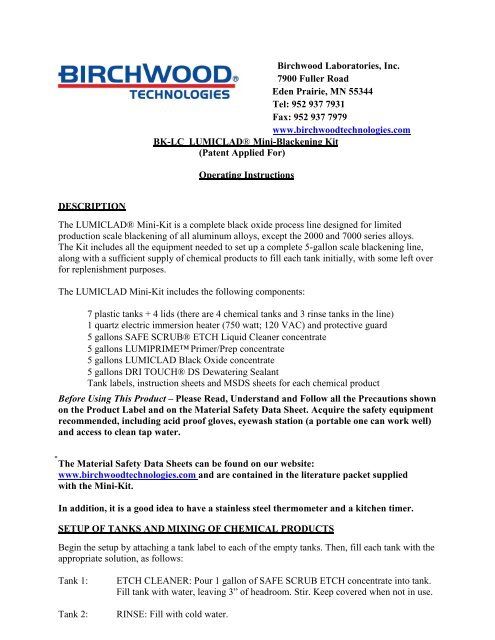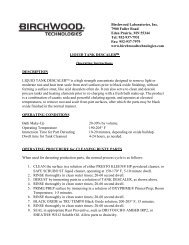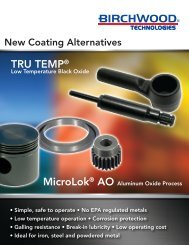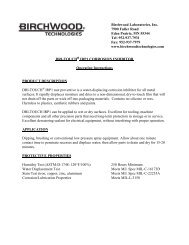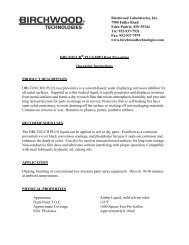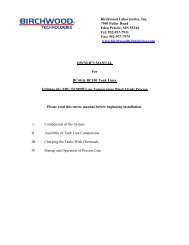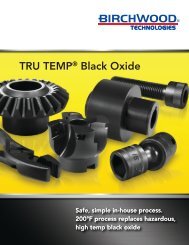Operating Instructions - Birchwood Technologies
Operating Instructions - Birchwood Technologies
Operating Instructions - Birchwood Technologies
Create successful ePaper yourself
Turn your PDF publications into a flip-book with our unique Google optimized e-Paper software.
<strong>Birchwood</strong> Laboratories, Inc.7900 Fuller RoadEden Prairie, MN 55344Tel: 952 937 7931Fax: 952 937 7979www.birchwoodtechnologies.comBK-LC LUMICLAD® Mini-Blackening Kit(Patent Applied For)<strong>Operating</strong> <strong>Instructions</strong>DESCRIPTIONThe LUMICLAD® Mini-Kit is a complete black oxide process line designed for limitedproduction scale blackening of all aluminum alloys, except the 2000 and 7000 series alloys.The Kit includes all the equipment needed to set up a complete 5-gallon scale blackening line,along with a sufficient supply of chemical products to fill each tank initially, with some left overfor replenishment purposes.The LUMICLAD Mini-Kit includes the following components:7 plastic tanks + 4 lids (there are 4 chemical tanks and 3 rinse tanks in the line)1 quartz electric immersion heater (750 watt; 120 VAC) and protective guard5 gallons SAFE SCRUB® ETCH Liquid Cleaner concentrate5 gallons LUMIPRIME Primer/Prep concentrate5 gallons LUMICLAD Black Oxide concentrate5 gallons DRI TOUCH® DS Dewatering SealantTank labels, instruction sheets and MSDS sheets for each chemical productBefore Using This Product – Please Read, Understand and Follow all the Precautions shownon the Product Label and on the Material Safety Data Sheet. Acquire the safety equipmentrecommended, including acid proof gloves, eyewash station (a portable one can work well)and access to clean tap water.The Material Safety Data Sheets can be found on our website:www.birchwoodtechnologies.com and are contained in the literature packet suppliedwith the Mini-Kit.In addition, it is a good idea to have a stainless steel thermometer and a kitchen timer.SETUP OF TANKS AND MIXING OF CHEMICAL PRODUCTSBegin the setup by attaching a tank label to each of the empty tanks. Then, fill each tank with theappropriate solution, as follows:Tank 1:Tank 2:ETCH CLEANER: Pour 1 gallon of SAFE SCRUB ETCH concentrate into tank.Fill tank with water, leaving 3” of headroom. Stir. Keep covered when not in use.RINSE: Fill with cold water.
Tank 3:Tank 4:Tank 5:Tank 6:Tank 7:PRIMER/PREP: Pour 1 gallon of LUMIPRIME concentrate into tank.Fill tank with water, leaving 3” of headroom. Stir. Keep covered when not in use.RINSE: Fill with cold water.BLACK OXIDE: Pour 2 ½ gallons of LUMICLAD concentrate into tank.Fill tank with water, leaving 3” of headroom. Stir.Mount quartz heater and guard on tank rim. Slide two small bolts (not included)through the outer holes on the plastic guard to keep it in place.Trim tank cover to fit around the heater. Keep tank covered when not in use.Plug in the heater and allow temperature to come up to 200° F.A rheostat may be added to control the heater.RINSE: Fill with cold water.SEAL: Fill tank with DRI TOUCH DS Dewatering Sealant.Keep covered when not in use.The Mini-Kit is now ready for blackening.BLACKENING TIPSWhen blackening aluminum parts, the general idea is to carry the parts down the line, from onetank to the next, timing each step to let each solution do its job. No drying is needed betweensteps – just let the parts drain for 5-10 seconds, then move them on to the next tank. Follow theguidelines shown on the next page. Once you have become familiar with the process, someexperimentation may help to optimize the immersion times for the parts being processed.Many parts can be carried on plastic coated, Romex-style wires, or stainless steel wire. Don’t usebare copper wires. Orient the parts so they get uniform chemical contact and good drainage.Small parts can be processed in bulk by carrying them in a plastic colander and rigging it up witha bail handle so the load can be gently jiggled during the reaction. Some mild agitation isgenerally helpful to break air bubbles and encourage uniform chemical contact. Heavily soiled oroxidized parts, or mill surfaces with visible ink markings, etc., should be glass bead blasted first.Otherwise, machined parts or aluminum surfaces in clean, clear condition can usually beblackened without blasting.PROCESSING PARTSThe LUMICLAD process uses the following process sequence:Tank 1:Tank 2:CLEAN/ETCH at room temp for 10 minutes. Some mild agitation is helpful here.You will see a noticeable gassing or “fizzing” of the parts in this tank as thesurface is cleaned and micro-etched. The parts take on a white aluminum color.RINSE in clean water for 20 seconds.Tank 3: APPLY PRIMER/PREP at room temp for 10 minutes. Thissolution deposits a thin layer of metallic zinc that will have a frosty, grayappearance.
Tank 4:Tank 5:Tank 6:Tank 7:RINSE in clean water for 20 seconds.BLACK OXIDE at 200° F for 10-15 minutes or until parts are uniformly black.The solution will gradually turn blue as it works.To minimize excessive heat loss, keep load size to a maximum of about 5 lbs.RINSE in clean water for 20 seconds.(Optional) SEAL & DISPLACE WATER at room temp; 1 minute.Immerse parts while they are still wet from the rinse. This product will displacethe water from the surface and deposit a very thin water-shedding film.Blow off excess liquid and allow parts to dry for 20 minutes.The sealant may be omitted if a dry, unsealed black finish is preferred.All the solutions in the line are completely stable in storage and deteriorate only throughblackening. Keep the four chemical tanks covered when not in use to keep the solutions cleanand to minimize water evaporation.The heated blackening tank will lose water to evaporation. No chemical content will be lost.Replace the water periodically by adding clean tap water to restore normal operating level.The rinse tanks get dirty faster than one might expect. It is a good idea to dump them OFTENand re-fill with fresh water – usually every 10-30 square feet of parts processed – in order toprevent contamination of the chemical solutions by residues carried in from previous tanks. Therinse water can be sent to the city drain, in most areas, without exceeding the normal dischargelimits.Sometimes, parts may turn out splotchy, due to incomplete cleaning or other surface problems. Ifso, examine the cleaning cycle to resolve these issues. You may need to bead blast. Then, youcan re-work the parts by running them through the process a second time in the normal manner.
LINE MAINTENANCEAs parts are processed, the solutions will gradually become weaker and will work moreslowly. Though the solutions have a fairly wide window of operation, it is necessary tomaintain their chemical strength in order to keep them working properly. Once the slowerreactions become noticeable, the operator can add small amounts of product concentrate toeach tank to strengthen the solutions.Normal replenishment would call for adding about ¼ of the amount used to initially fill thetanks, or about 1-2 quarts of product concentrate added to each tank. Once thereplenishment equals about twice the original makeup volume, it is time to change out thesolutions and mix fresh. Follow the instructions given earlier to re-mix a fresh solution.The Dewatering Sealant in Tank 7 does not get weaker with use, but over time the water itdisplaces from the parts will accumulate at the bottom of the tank. It is recommended that theoperator drain this water out of the tank occasionally, then refill the tank with fresh product.The best way to do this is to slowly decant the clear liquid off the top into another pail. Then,discard the water. From here the sealant can be poured back into the tank and topped up.All the chemical products used in the Mini-Kit can be purchased from BIRCHWOODTECHNOLOGIES in 1-gallon or 5-gallon sizes, as needed. See the enclosed price schedule.DISPOSAL OF SPENT BATHSWhen it is time to change out the solutions, the operator has two options:1. The spent solutions can be accumulated in a 55-gallon plastic drum. When thedrum is full, it can be sent out for disposal with Safety Kleen Corp or Siemens WaterTreatment or other disposal firms. They will take ownership of the materials andcharge a fee for their service.2. Or, you can dispose of two of the baths yourself, then send the third one out, asfollows: Tank 1 does not contain any EPA regulated metals, but it does containcaustic soda.The solution can be carefully neutralized, to between pH 5-10, with powdered citricacid or liquid phosphoric acid (it takes about two quarts), then poured into the drain.Tank 5 is already at a neutral pH and can be poured into the drain without treatment.Tank 3 does contain a small amount of zinc, which is EPA regulated. The spentsolution should be accumulated and sent out for treatment with one of the firmsmentioned above. Tank 7 should never require dumping. It is just used up and replacedwith fresh product.PLEASE CALL BIRCHWOOD TECHNOLOGIES WITH QUESTIONS: 952 9377931BK-LC LUMICLAD® Mini-Kit (Part No. 890408)
© <strong>Birchwood</strong> Laboratories,Inc. October 2010


